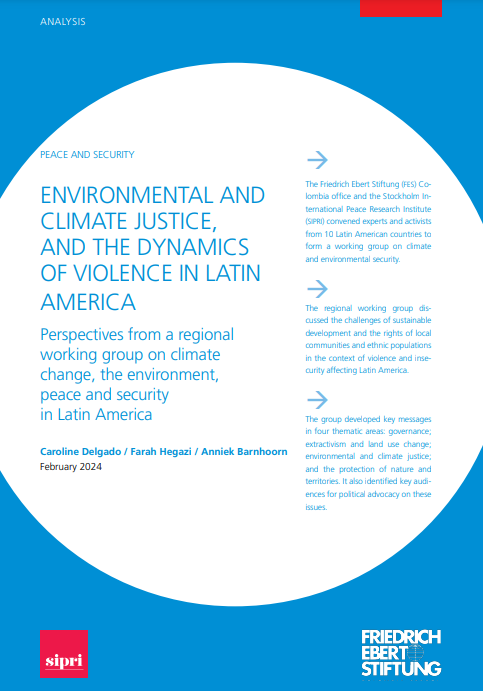By Caroline Delgado , Farah Hegazi and Anniek Barnhoorn
The Latin American Regional Working Group was initiated by the Friedrich-Ebert-Stiftung (FES) Colombia office and the Stockholm International Peace Research Institute (SIPRI) in 2022. The working group comprises 20 climate and environmental experts from 10 Latin American countries. This report presents the collective perspective of the working group on the pressing issues surrounding climate and environmental justice, as well as food security, that affect the region as a whole, but whose impact is most strongly felt at the local level. The report is accompanied by a brief interview series of 4 working group members, addressing the challenges of environmental security in the region from their individual perspectives. Latin America and the Caribbean (LAC) is a region of unparalleled ecological diversity, encompassing tropical rainforests, arid deserts, and expansive coastlines, making it particularly susceptible to the far-reaching impacts of climate change and environmental degradation. Beyond its diverse and unique natural landscapes, Latin America faces a complex web of climatic and environmental challenges that transcend national borders. From the melting glaciers of the Andes Mountains, which threaten water security for millions, to deforestation in the Amazon rainforest, which jeopardizes biodiversity and global carbon sequestration, the region grapples with issues that have far-reaching implications for both local communities and the international community. Projections for how climate change will affect Latin America indicate that temperatures are expected to increase across the region and rainfall patterns are expected to change. Extreme events such as droughts and floods are also predicted to increase in frequency and intensity. In a region heavily dependent on agriculture, changes to temperature and precipitation patterns will have negative implications for food production and security. Crop yields are expected to decrease, increas ing food insecurity and malnutrition in the region. Furthermore, the projected degradation of forests from droughts and temperature increases is expected to reduce the availability of forest products. At the same time, Latin America is expected to meet part of the growing global demand for food, livestock and timber, which risks exacerbating environmental degradation linked to inadequate land management practices associated with the expansion of large-scale agriculture. Of particular concern is the way climate and environmental challenges intersect with social inequalities and political instability. This region endures various forms of violence, from armed conflicts to rampant criminal violence on par with armed conflicts. The region stands out as one of the world’s most violent. According to UNODC figures from 2023, LAC accounts for 29% of global homicides, in a region with 8% of the world’s population. The region is home to 8 of the 10 most homicidal countries and 15 of the most lethal countries. Seven of the top 10 cities by homicide rate are in LAC. LAC is also the region with the highest number of environmental conflicts and a hotspot for environmental crime. Many of these conflicts are linked to the legal and illegal extraction of natural resources, which often intersects with other criminal economies, such as drug trafficking, human trafficking, and contraband smuggling. A multitude of nonstate armed groups, including gangs, cartels, smuggling networks, militias, and vigilante groups, are among the main perpetrators of this violence. According to some sources, mining companies at times voluntarily cooperate with illegal armed groups, who in exchange provide security against other groups. Consequently, Latin America is one of the most dangerous regions for environmental defenders, with 75 percent of all global assassinations of human rights advocates that occurred between 2015 and 2019 taking place in LAC. In 2022, 20 percent of assassinations of human rights defenders occurred in the Amazon region.9 Communities and environmental defenders in areas where extractive activities take place frequently have been subjected to gross human rights violations, with such attacks on the rise across LAC. In addition to killings, death threats, arbitrary arrests, sexual assaults, militarized policing, judicial harassment, intimidation, beatings, and other forms of violence are used to silence the complaints of local communities and thwart their attempts to use legal means of protest against extractive projects. Environmental defenders have also been repressed and criminalized by the governments that should be protecting them. Criminal violence, including environmental crime, is largely concentrated in rural areas with poor state presence and strong illicit economies and in the poor neighbourhoods of cities. As such, the main victims of violence are the socio-economically poor and disadvantaged, including ethnic minorities such as indigenous and afro-descendant populations, gender minorities, women, and subsistence farmers. Around half of all homicide victims are between 15 and 29 years old. Violence against social leaders, including environmental and human rights defenders, also tends to disproportionately affect low-income people and ethnic minorities. Furthermore, current extractive violence is largely fed by the prejudices and legacy of earlier racial and class conflicts.....
Stockholm, SIPRI, 2024. and Friedrich-Ebert-Stiftung (FES) Calle 71 nº 11-90 | Bogotá-Colombia 2024. 25p.





















